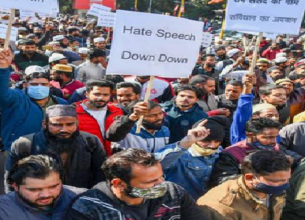CJI’S OFFICE COMES UNDER AMBIT OF RTI ACT, SC SAYS
14, Nov 2019

Prelims level : Judiciary
Mains level : GS-II Structure and Functioning of Judiciary
Why in News?
- The office of the Chief Justice of India is a public authority and falls under the ambit of Right to Information Act, the Supreme Court ruled today.
Highlights:
- The five-judge bench of CJI Ranjan Gogoi, Justices N V Ramana, D Y Chandrachud, Deepak Gupta and Sanjiv Khanna passed the judgment on an appeal filed by the Supreme Court administration.
- The appeal challenged the 2010 order of the Delhi high court which held that the CJI’s office comes under the ambit of the Right to Information Act.
- Oppositions to the plea had contended that courts had time and again given a slew of directions to infuse transparency in the functioning of various institutions.
- The bench had agreed that there should be transparency, but added there was a need to do balancing.
Who is a “Public Authority”?
- In 2011, the Punjab-Haryana High Court while deciding on 24 civil writ petitions against the Central/State Information Commissioners had held that if any person, or body, satisfies the following conditions then it would “squarely fall within the ambit and scope of definition of ‘public authorities’” and would be “legally required to impart the indicated information as envisaged under the RTI Act” –
- The institution cannot come into existence and function unless registered and regulated by the provisions of a legislation; or the State Government has some degree of control over it through the medium of Acts/Rules; or it is substantially financed by means of funds provided directly, or indirectly, by the appropriate Government; or the mandate and command of the provisions of the RTI Act along with its Preamble, aims, objects and regime extends to their public dealing; or The larger public interest and totality of the other facts and circumstances emanating from the records suggest that such information may be disclosed.
The Delhi High Court order:
- In a landmark verdict on January 10, 2010, the Delhi High Court had held that the office of the Chief Justice of India comes within the ambit of the RTI law.
- It said that the judicial independence was not a judge’s privilege, but a responsibility cast upon him.
- The 88-page judgment was then seen as a personal setback to the then CJI, KG Balakrishnan, who has been opposed to disclosure of information relating to judges under the RTI Act.
- The apex court said that the right to privacy and confidentiality is an important aspect and has to be balanced while taking a decision on giving out information from the CJI’s office.
- The CJI-led bench added that transparency cannot be allowed to run counter to right to privacy. The bench said that the information commissioner must apply test of proportionality while entertaining applications seeking information from the CJI’s office.
- However it must keep in mind right to privacy and independence of judiciary.
Judicial Accountability:
- Judiciary accountability generally refers to the “answerability or responsibility” of the judiciary to the various segments.
Relation between Judicial Accountability and Judicial Independence:
- The principal of judicial independence is not meant to benefit the Judges; it is meant to guarantee a fair and impartial hearing and an unswerving obedience to the rule of law.
- It is also universally accepted that the judiciary has to be independent and impartial and to be so it must also enjoy some degree of immunity.
- However, Accountability is necessary to prevent any judicial delinquency and ensuring the efficient functioning of the judiciary.
- Thus, the Independence and Accountability are two sides of the same coin and they complement each other.
Need for Judicial Accountability in India:
- Power and position in a democracy is depicted as attendant with responsibility, and every incumbent of a public office must remain constantly accountable to the people.
- The People’s Convention on Judicial Accountability and reform-2017, held in New Delhi observed that the “The Judicial System of India, remains dysfunctional for the weak and the poor when it comes to protecting their rights”
- Therefore, any accountability must be comprehensive to include not only the politicians, but also the bureaucrats, judges and everyone invested with power.
Judicial Accountability in India:
- The Constitution has provided in Article 235, for the ‘control’ of the High Court over the Subordinate Judiciary clearly indicating the provision of an effective mechanism to enforce accountability.
- The Conference of Chief Justice held in 1996, resulted in a Code of Conduct being adopted.
- Full Court Meeting of the Supreme Court in 1997 adopted a resolution relating to the declaration of assets by the judges.
- And the SC also adopted a resolution that the allegations against a Judge would be examined by his peers and not by an outside agency and thereby, the independence of the judiciary can be maintained.
- The Judges Inquiry Act, 1968, contains details regarding the impeachment process of the Judges.









